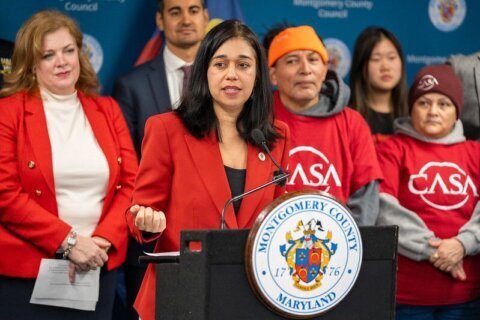This article was republished with permission from WTOP’s news partners at Maryland Matters. Sign up for Maryland Matters’ free email subscription today.
This content was republished with permission from WTOP’s news partners at Maryland Matters. Sign up for Maryland Matters’ free email subscription today.
Legislation pending in the Senate would add yet another member to the Maryland Stadium Authority board — this one appointed by the Prince George’s County executive — and provide for $20 million in bond money to be available for bus rapid transit system grants each year in Montgomery County.
House Bill 524, as amended, would raise the number of seats on the Stadium Authority board to 10 — an even number, with no provision for a tie-breaker vote — giving Prince George’s County a literal seat at the table. The bill is now in the Senate Budget and Taxation Committee.
Meanwhile, the House Appropriations Committee is considering Senate Bill 442, sponsored by Sen. Paul D. Corderman (R-Washington), that would allow for the Stadium Authority to sell an additional $20 million in bonds to cover the shortfall for construction of the Hagerstown Multi-Use Sports and Events Facility. That project would provide the home to a new Class A minor league baseball team.
The new board appointment, subject to the advice and consent of the Senate, has its roots in an appropriation bill last year that authorized the Stadium Authority to sell up to $400 million in bonds to pay for construction of buildings — a stadium is explicitly prohibited under the law — in the so-called Blue Line Corridor in Prince George’s County.
The money was approved as an effort to jump-start transit-oriented development along the Washington Metrorail’s Blue Line.
“We now have Bowie [Baysox] Stadium getting funding, and we have a $400 million Blue Line Corridor,” said Del. Benjamin S. Barnes (D-Anne Arundel and Prince George’s), chair of the Appropriations Committee. “We thought given that sort of amount of money, it made sense … [that] much like the mayor of Baltimore gets a seat, the county executive gets to appoint a seat.”
The Baltimore mayor appoints a member of the Stadium Authority board, with the advice and consent of the Senate, because Oriole Park at Camden Yards and M&T Bank Stadium, home Baltimore Ravens football team — both built by the Maryland Stadium Authority — are located in the city.
Barnes said that a Prince George’s County seat was important because “given the amount of money flowing through there … [to] have somebody on the board to sort of speak for those interests, keep an eye on that money and make sure it’s being directed in the appropriate ways.”
As for the question of an even number of board members, Barnes said, “I don’t think you get a lot of contested votes over there at the Stadium Authority. This is just people who have a voice in the room, the room where it happened.”
The annual $20 million for Bus Rapid Transit Fund grants was included in the pending bill to allow Montgomery County to tap into the $27 million in State Lottery Fund that are deposited each year in the Maryland Stadium Facilities Fund for disbursal to eligible grantees. That annual $27 million was mandated to be set aside for the grants in the 2022 legislation that authorized $400 million for the Blue Line Corridor project.
The new bill would establish a Bus Rapid Transit Fund in the Maryland Department of Transportation where the lottery money would be deposited each year. Montgomery County, as one of the few “eligible” jurisdictions in the state, would be able to float bonds for bus rapid transit projects, based on the $20 million each year.
“This was something they brought up this summer, that they want to bond the money,” Barnes said. “Frankly, it’s not that big a deal. There’s just no reason not to let them bond it. It lets them [get] cash up front.”
The original legislation, a department bill, would establish a Camden Yards Football Sports Facility Supplemental Financing Fund and a Camden Yards Baseball Sports Facility Supplemental Financing Fund, based on money in the State Lottery Fund.
The Corderman bill for the Hagerstown Multi-Use Sports and Events Facility would cover the higher-than-expected costs of the project, owing to climbing interest rates, inflation and increased acquisition costs. The original cost was projected to be $79.7 million, $57.6 million of came from Stadium Authority bond sales, a Department of Legislative Services (DLS) analysis found earlier this year.
The Stadium Authority, however, advised DLS in December that based on current estimates, the scope of the project would either have to be reduced or funding increased, estimating that an additional $17 million was needed to cover the costs.
The biggest increase was the $6.25 million acquisition cost for one of the land parcels needed for the project — a 79% increase over the appraised value, the analysis read.
“There’s a big hole there,” Barnes, the Appropriations chair, said. “I don’t think we can just let it go …. We gotta do something.”







